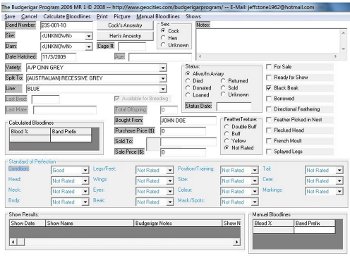



Most farmers also have a pocket notebook to record day-to-day activities. Most of these diaries contain livestock recording sections, allowing you to keep all your stock information in one book. Specially designed rural diaries allow you to keep simple, specific records under prepared headings. Individual requirements will determine the entries made and the detail recorded. It is used to record major activities carried out on the property. Property records Farm diaryĪlmost every producer maintains a farm diary. Various programs are available according to the level of record keeping required. Such programs not only store information but can be used to analyse data and generate simple or detailed production and financial summaries.
BIRD BREEDING RECORD KEEPING SOFTWARE SOFTWARE
Software is continually being developed, enabling relevant information to be entered quickly and easily. ComputersĬomputers are rapidly becoming the preferred and most efficient form of record keeping. Records should be transferred to a summary sheet for easy interpretation and should ideally be linked to your financial recording system. This applies to both physical and financial aspects of your farm business. It is worth recording only the information you will use. Keep your record system simple and concise. The records suggested in this Agfact are all suitable for meeting the requirements of LPA, CATTLECARE and the MSA grading scheme. Quality assurance programs, such as Livestock Production Assurance (LPA), CATTLECARE, and the Meat Standards Australia (MSA) grading scheme, require records as part of their assurance elements. Records are needed not only for legal, financial and taxation purposes but also for maintaining a permanent record of the farm business, analysing the business, monitoring day-to-day activities, and future planning. Record keeping is a key component of managing an efficient farm business. While the emphasis is on commercial herd records, the options apply to seedstock producers as well. This Agfact, the first of the two-part series, looks at property and whole-herd record-keeping options, and management planning. Each record should have a specific objective and be used for that purpose. The number of records maintained and the detail recorded will vary according to individual needs and how the information is to be used. They can be changed to suit your particular needs.

The recording systems outlined present a package of practical records for beef producers.


 0 kommentar(er)
0 kommentar(er)
